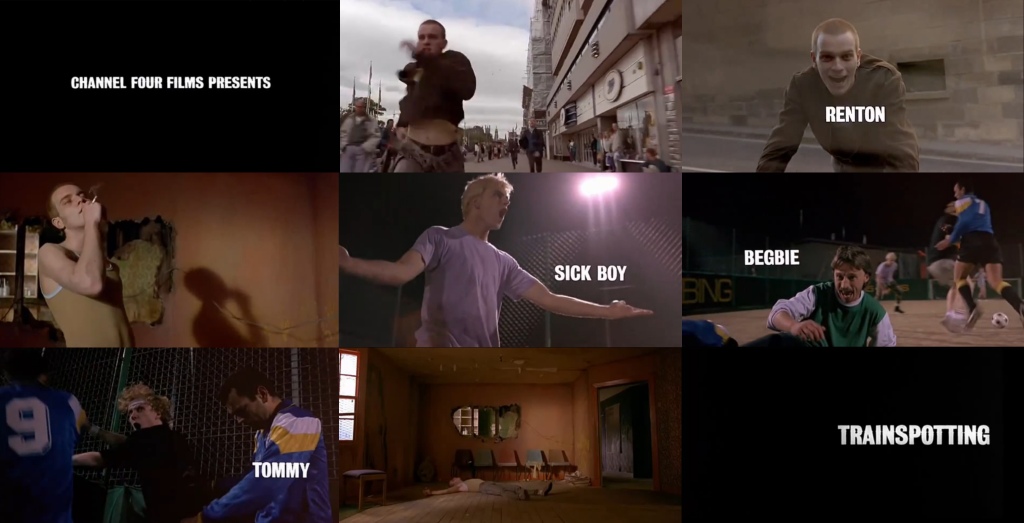Narrative:
Renton’s fast paced, energetic and almost poetic narration connects the scenes in the film, acting as a bridge to maintain a constant fast pace. His narration is accompanied by visuals, such as when Begbie finishes Renton’s sentence, speaking directly to the audience and thereby breaking the fourth wall. His narration is rhythmic, bridging the large ellipses between scenes, which are used to compress time in this opening sequence to give the audience an introduction to the lives and personalities of these characters.
Key Elements:
The film opens with an ‘in media res‘, or a cold open, immediately cutting to a low angle shot of feet running from an unseen threat, then cutting to Renton and Spud, who we do not know, running from security guards for reasons we do not know. This is done too shock the audience, throwing them into the story and the pace of the film, overwhelming them with the sudden information. The song ‘Lust for Life’ by Iggy Pop plays to the scene, lending an upbeat energetic pace to the scene, but also conveying the shared culture and tastes of the protagonists, who would have grown up listening to this type of music, as it was released in 1977.
The film is rapidly edited with unusual angles, a playful style of cinematography, such as the arching shot of Renton on the floor. Another example of the playful editing and camerawork is the action match between Renton falling on the football pitch to him falling in the drug den. It uses freeze frames and captions to introduce the ensemble cast of characters, which also breaks the fourth wall, a narratively engaging strategy. The film also uses highly exaggerated, heightened mise en scen, such as the red drug den and the green hallway outside it. The film is rooted in British social realism, but presents a grim situation in a mostly comedic, fun, even exotic way.
The film is highly expressive, conveying the lives and circumstances of the protagonists in a light, comedic, even cartoonish way. For example, the film conveys Renton’s addiction and his struggles to get off heroin through the comically jagged planks of wood that he uses to lock himself in his room. He then comedically breaks these down to escape, which is unrealistic, and so the film is not true to British social realism, but presents the grim subject matter in a lighthearted and fun way. It is storytelling through metaphor. This is most done i8n the ‘worst toilet in Scotland’ scene, where Renton literally climbs into a toilet to retrieve some suppositories. In the next scene, he is soaking wet, even though we, the audience, understand that he did not actually climb in. The toilet itself is comically and unrealistically dirty, to the point of absurdism. This is a metaphor, done to convey the filth and squalor that Renton lives through in a funny and comedic way.
Ideology:
Renton’s omniscient narration plays over the scene. In it, he sarcastically mocks the ‘choose life’ anti-drug campaign, in which he rejects stereotypical middle-class values, instead embracing hedonism, approaching life in a nihilistic way, rejecting the status quo, authority, social conventions and aspirations. He instead chooses to live a life for pleasure, claiming, “why? There are no reasons. Who needs reasons when you’ve got heroin?”.
His message has a strong counter-culture message to appeal to the younger audiences. Renton has an angry, defiant punk attitude, and is made likeable through his intelligence, charm, and enthusiasm. The 1970/80s cultural references are targeted at the more youthful audience, e.g., Sick Boy talking about James Bond, making pop culture references for the younger British generation watching.

You must be logged in to post a comment.